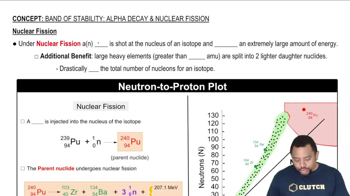Here are the essential concepts you must grasp in order to answer the question correctly.
Isotopes
Isotopes are variants of a chemical element that have the same number of protons but different numbers of neutrons, resulting in different atomic masses. The stability of isotopes is influenced by the balance between the number of protons and neutrons in the nucleus, which affects nuclear stability. Elements can have multiple stable isotopes, while others may have only one or be predominantly unstable.
Recommended video:
Nuclear Stability
Nuclear stability refers to the ability of an atomic nucleus to remain intact without undergoing radioactive decay. This stability is determined by the ratio of neutrons to protons; a balanced ratio generally leads to stability. Elements like neon and magnesium have isotopes that achieve this balance, while sodium and aluminum do not, resulting in fewer or no stable isotopes.
Recommended video:
Band of Stability: Nuclear Fission
Elemental Composition
The elemental composition, including the number of protons and neutrons, plays a crucial role in determining the isotopes of an element. Elements with higher atomic numbers tend to have more isotopes due to the increased number of neutrons required to offset the repulsive forces between protons. Sodium and aluminum, being lighter elements, have fewer stable isotopes as their nuclear configurations do not support multiple stable forms.
Recommended video:
 Verified step by step guidance
Verified step by step guidance

